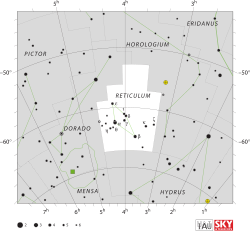
| |
| Observation data Epoch J2000.0 Equinox J2000.0 (ICRS) | |
|---|---|
| Constellation | Reticulum |
| Right ascension | 04 17 40.27169 |
| Declination | −63° 15′ 19.4882″ |
| Apparent magnitude (V) | 5.88 6.05 + 7.65 |
| Characteristics | |
| θ Ret A | |
| Spectral type | B9IV |
| B−V color index | −0.09 |
| Variable type | suspected |
| θ Ret B | |
| Spectral type | kA2hA5VmA7 |
| B−V color index | +0.14 |
| Astrometry | |
| θ Ret A | |
| Radial velocity (Rv) | 3.0±7.4 km/s |
| Proper motion (μ) | RA: +6.273 mas/yr Dec.: +35.360 mas/yr |
| Parallax (π) | 7.0053 ± 0.0401 mas |
| Distance | 466 ± 3 ly (142.7 ± 0.8 pc) |
| Absolute magnitude (MV) | −0.04 |
| θ Ret B | |
| Proper motion (μ) | RA: +8.512 mas/yr Dec.: +35.235 mas/yr |
| Parallax (π) | 7.1837 ± 0.0540 mas |
| Distance | 454 ± 3 ly (139 ± 1 pc) |
| Details | |
| θ Ret A | |
| Mass | 3.363±0.117 M☉ |
| Luminosity | 179 L☉ |
| Temperature | 11,967 K |
| Rotation | 2.9686 d |
| Age | 166 Myr |
| θ Ret B | |
| Mass | ≥ 1.18 M☉ |
| Temperature | 9,132 K |
| Age | 200 Myr |
| Other designations | |
| θ Ret, CD−63°143, HD 27657, HIP 20020, HR 1372, WDS J04177-6315 | |
| θ Ret A: NSV 1556, GC 5233, SAO 248986 | |
| θ Ret B: GC 5232, SAO 248985 | |
| Database references | |
| SIMBAD | data |
| A | |
| B | |
Theta Reticuli is double star in southern constellation of Reticulum, located just 50′ south of Alpha Reticuli. The pair are visible to the naked eye as a dim, white-hued point of light with a combined apparent visual magnitude of 5.88. They lie at roughly the same distance from the Sun based on parallax, with the primary being around 466 light-years away. They also share a similar proper motion, suggesting they may be gravitationally bound.
The magnitude 6.05 primary, designated component A, has a stellar classification of B9IV, matching a B-type subgiant. It is 166 million years old with 3.4 times the mass of the Sun. The star is radiating 179 times the Sun's luminosity from its photosphere at an effective temperature of 11,967 K.
As of 2015, the magnitude 7.65 secondary, component B, had an angular separation of 4.10″ from the primary along a position angle of 3°. It is most likely a very young main-sequence star, and is an Am star with a stellar classification of kA2hA5VmA7. This notation indicates the spectrum displays the K-line of an A2-type star, the hydrogen lines of a cooler A5 star, and the metal lines of an A7 star. This system is a source of X-ray emission, which may be coming from the companion.
References
- ^ Brown, A. G. A.; et al. (Gaia collaboration) (August 2018). "Gaia Data Release 2: Summary of the contents and survey properties". Astronomy & Astrophysics. 616. A1. arXiv:1804.09365. Bibcode:2018A&A...616A...1G. doi:10.1051/0004-6361/201833051. Gaia DR2 record for this source at VizieR.
- ^ Anderson, E.; Francis, Ch. (2012), "XHIP: An extended hipparcos compilation", Astronomy Letters, 38 (5): 331, arXiv:1108.4971, Bibcode:2012AstL...38..331A, doi:10.1134/S1063773712050015, S2CID 119257644.
- ^ Høg, E.; et al. (2000), "The Tycho-2 catalogue of the 2.5 million brightest stars", Astronomy and Astrophysics, 355: L27, Bibcode:2000A&A...355L..27H, doi:10.1888/0333750888/2862, ISBN 978-0333750889.
- ^ Corbally, C. J. (1984), "Close visual binaries. I - MK classifications", Astrophysical Journal Supplement Series, 55: 657, Bibcode:1984ApJS...55..657C, doi:10.1086/190973.
- Samus, N. N.; Durlevich, O. V.; et al. (2009), "VizieR Online Data Catalog: General Catalogue of Variable Stars (Samus+ 2007-2013)", VizieR On-line Data Catalog: B/GCVS. Originally Published in: 2009yCat....102025S, 1: B/gcvs, Bibcode:2009yCat....102025S.
- ^ Hubrig, S.; et al. (June 2001), "Search for low-mass PMS companions around X-ray selected late B stars", Astronomy and Astrophysics, 372: 152–164, arXiv:astro-ph/0103201, Bibcode:2001A&A...372..152H, doi:10.1051/0004-6361:20010452, S2CID 17507782.
- ^ Brown, A. G. A.; et al. (Gaia collaboration) (August 2018). "Gaia Data Release 2: Summary of the contents and survey properties". Astronomy & Astrophysics. 616. A1. arXiv:1804.09365. Bibcode:2018A&A...616A...1G. doi:10.1051/0004-6361/201833051. Gaia DR2 record for this source at VizieR.
- Barraza, L. F.; Gomes, R. L.; Messias, Y. S.; Leão, I. C.; Almeida, L. A.; Janot-Pacheco, E.; Brito, A. C.; Brito, F. A. C.; Santana, J. V.; Gonçalves, N. S.; Das Chagas, M. L.; Teixeira, M. A.; De Medeiros, J. R.; Canto Martins, B. L. (2022). "Rotation Signature of TESS B-type Stars. A Comprehensive Analysis". The Astrophysical Journal. 924 (2): 117. arXiv:2202.01022. Bibcode:2022ApJ...924..117B. doi:10.3847/1538-4357/ac3335. S2CID 246030494.
- "tet Ret". SIMBAD. Centre de données astronomiques de Strasbourg. Retrieved 2019-09-02.
{{cite web}}: CS1 maint: postscript (link) - Streicher, Magda (December 2009), "Reticulum: The Celestial Crosshairs", Monthly Notes of the Astronomical Society of South Africa, 68 (11 and 12): 242–246, Bibcode:2009MNSSA..68..242S.
- Eggleton, P. P.; Tokovinin, A. A. (September 2008), "A catalogue of multiplicity among bright stellar systems", Monthly Notices of the Royal Astronomical Society, 389 (2): 869–879, arXiv:0806.2878, Bibcode:2008MNRAS.389..869E, doi:10.1111/j.1365-2966.2008.13596.x, S2CID 14878976.
- Mason, B. D.; et al. (2014), "The Washington Visual Double Star Catalog", The Astronomical Journal, 122 (6): 3466, Bibcode:2001AJ....122.3466M, doi:10.1086/323920.
| Constellation of Reticulum | |||||||||||
|---|---|---|---|---|---|---|---|---|---|---|---|
| Stars |
| ||||||||||
| |||||||||||
| Galaxies |
| ||||||||||
| |||||||||||